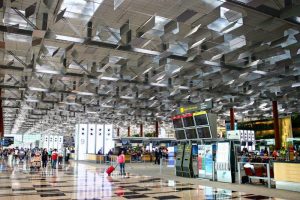There is a saying, of course, that he who goes first wins. And sometimes, and in some ways, that is true. But not always, and especially not always in the long run.
Forlorn Hope
The most obvious example of going first being dangerous is the forlorn hope in a military context. They were the first people through a breach in the castle wall or whatever. Casualties were likely to be very high. To make this attractive, the rewards for survival were riches and promotions (and glory).


subway station in Beijing
London Underground
Here’s a different type of example. The London Underground (the “tube” – or subway, in American terms) was opened in 1863. Initially, the tunnels were near the surface and were built by “cut and cover” – a big ditch is dug out, the tunnel is created, and then the surface is replaced. But later, the deeper lines were built with circular tunnels. These lines had to be built with Victorian tunneling technology. As a result, the tunnels are too narrow, and they are very windy since Victorian tunneling technology was not up to going through hard rock, so it had to go around. So that is what London is stuck with. You can’t exactly widen a tunnel while keeping service running for about 20 hours per day. This is the same problem New York has with the Holland rail tunnel, which was one of the motivations for wanting to build a second tunnel. The problem for London with the small bore is that the trains are very crowded. They are very hot in summer – there is no air conditioning and the tunnels are too small to add it. Some of the stations are very curved, leading to the famous “mind the gap” announcements (and by the way, it is an urban legend that the guy who voiced that message gets a royalty each time it is said).
So the bottom line is that London had an underground railway when nobody else did, but it is stuck with 150-year old decisions that can’t be changed. You know why Beijing’s subway is better? Because they only really built it for the 2008 Olympics, so they could use modern technology and techniques.


Mobile Payment
M-Pesa
Do you know what M-Pesa is? Pesa is the Swahili for “money” (this blog is nothing if not educational) and the “M” stands for mobile. It is a money transfer system in Kenya and Tanzania for moving money around using cheap (not smart) phones. It is ahead of anything else until, maybe, smartphones came along. Almost nobody in those countries has a bank account, and so everything operated in cash. Of course, if your son were in the city and wanted to get money to you, either he or a trusted friend had to hop on a bus and give it to you in person. Of course, lots of robberies took place. M-Pesa now carries nearly half the country’s GDP. When I was in Tanzania doing Kilimanjaro a couple of years ago, there were shacks at the side of the road with M-Pesa signs that were effectively mini-banks.
Mobile payments have been slow to take off in the US because we already have a good credit card system. It even took a decade after most of the world to put a chip in the credit cards since there were pretty good fraud detection systems by then. Now Apple Pay works really well, taking only a split second, whereas those credit cards with chips seem to take forever to do a transaction, confusingly saying “thank you” and then going back to telling you not to remove your card.


Changi International Airport, Singapore
Airports and Bridges
The US is famous for bad airports, especially as compared to Asia. Changi in Singapore is regularly rated best airport in the world. To be honest, I think we do OK here, and SFO is fine, and with the best food of any airport anywhere. Famously, Paris’s main airport CDG has really bad food, especially for a country that prides itself on its food. (And here’s another bit of education for you: if you are in Paris, it is considered hick behavior to call it “Charles de Gaulle” airport – it is always Roissy, the village beside where the airport was built.) But again, part of the problem is those bad airports (like JFK) were built really early and it is hard to rebuild an airport and keep it running. The best solution would be to build a new one and cutover like Munich or Denver did.
However, there does seem to be another problem with public infrastructure projects in the US, which is that they are not regarded as a way to get infrastructure built, but as a way to deliver patronage and employ people. If we were serious about building the Second Avenue subway line in Manhattan, we’d just get a Chinese company to do it for 25 cents on the dollar or less. Instead, we have a fiasco. The line was planned in 1919 and construction started in 1972. The first small phase opened finally at the start of this year. The “big dig” in Boston, the new Bay Bridge, every light rail line ever, all run multiple times over budget in both dollars and time because we are not serious about getting them built, we are more concerned to use American steel, and union labor and so on, and lots of it.
If you lived in the Bay Area about ten years ago, you might remember when a tanker truck caught fire under a section of 580 and took down a bridge. For once, people focused on getting it open, and within 24 hours – without even a contract in place (thus breaking all the rules for contracting public works) – a demolition company was getting rid of the old bridge. The new one opened about 30 days later. So it is possible if what is important is delivering to the public, rather than patronage.
And it wasn’t always this way. Although the new span of the Bay Bridge only opened in 2014-25 years after the 1989 earthquake that showed up the problems – the original Bay Bridge was built in 3 years. We just don’t seem to be able to do that anymore.
New EDA Point Tools
Things have changed a bit in the last few years in EDA, which I’ll get to later, but it used to be extremely difficult to introduce a new product into the channel because the salespeople knew that going first was a recipe for problems. The product was immature, and the salesperson and associated AE team would have to spend time addressing them. Everyone sat on their hands, waiting for others to go first so that when the product was mature, they could rush in. Nobody wanted to be the forlorn hope; the rewards were not big enough.
This was brought home to me after Cadence acquired Ambit in the late 1990s (I was VP Engineering). We had a synthesis product (amusingly named BuildGates), and Cadence had recently canceled their own internal development on Synergy. It was important that the product be sold aggressively to justify the high purchase price (nearly $300M if I remember right). But the salesforce would not. The Cadence salesforce was accustomed to closing deals on the basis of trying to get the entire budget except for synthesis. Very few customers (Philips was the only one) were going to make a wholesale switch, but they would probably take a few copies, and then maybe lots later. No salesperson wanted to risk messing up a multi-million dollar deal for a few hundred thousand dollars on a product they knew little about. While there were some sales, the sales goals were missed by a lot.
Another Cadence example was back in the same era. We had developed a lot of formal verification technology at the Cadence Berkeley Labs. This was then transferred to Cadence proper and productized under then name “Heck”. This was not a good way to work anyway – you can only really move technology in people’s heads – but that’s a topic for another day. I have no idea if the technology was any good; in that era, formal verification was a niche market and very hard to use. But again, we never found out, since the sales team refused to sell it, and after about a year it was quietly dropped.
Hunters and Farmers
This is one reason that back in that era when you could sell a point tool without needing it to be completely integrated across the entire flow, startups could sell products. Their sales people were hunters, finding the early adopters to get the product across the chasm, as opposed to the sales forces of the big companies who were farmers, working the fields of the big customers.
So the strategy of the ecosystem was to develop new technology in startups. They would get the product moving in the channel, then the big companies would buy the successful companies. Then the farmers would move in. If the big companies developed internal technology, the salesforce would not sell it and it would fail. You can’t get a point tool started with the farmer approach.
There are only a couple of products I can think of back in that era that were developed by big EDA companies (once they were out of their own startup phase) that became successful; these were Calibre and PrimeTime (and even that second one is dubious since the #1 product in the space, Motive, was acquired and shut down, leaving a vacuum to move into).
Today
I think the situation today is actually a bit different. Each new process generation brings new challenges (FinFET, double patterning etc) and so any leading edge customer has no option but to adopt the new version. Everyone – Cadence and the customer – knows there will be issues. Everyone knows we will all have to work together to solve them. There are still one or two startups in little niches, but they are the exception and far less numerous than twenty years ago when DAC would not just fill part of the south hall at Moscone, but all of it. And the North Hall, And use the corridors in between as overflow space for still more companies.
Solving problems together has always been the case to some extent. When I was one of Cadence’s co-CTOs, I used to end up in arguments with the VP Engineering of one of our big customers. He would complain that our software was buggy for leading edge nodes. I would tell him to use an old version, but we both knew that was impossible; the capabilities were not available in the old version. Then we would have some test cases in the new node before we released the software, and we’d test it better. But this was also a non-starter since the test cases can’t be produced until the software is – if not up and running – at least up and staggering. So actually the situation was the same back then, but less well acknowledged.
The startup approach no longer works. This is partially due to the investment climate, but also because the problems to be solved (such as coloring vias) require you to have a full flow already. There is no niche for the “via coloring company,” no matter how compelling the technology. It has to work in layout, place and route, physical verification and so on, so you have to have it all already.











